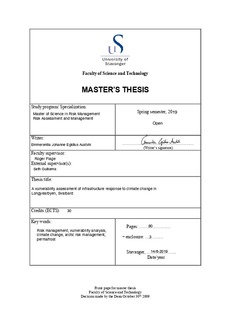| dc.description.abstract | During the last decades, climate change has been a heavily debated theme in both the news media and in the academic world. A warmer climate will have huge implications for large areas around the world, and the Arctic has received special concerns related to climate change lately. Because of polar amplification, temperatures will rise much faster in the Arctic and Antarctic regions than in the rest of the world. One of the consequences of climate change is thawing of permafrost, which potentially can damage buildings and infrastructures that are constructed on top of it. Because heat is transferred from building to ground, it results in the ground to move which consequently makes the buildings move as well. This phenomenon will be further impaired by climate change.
The main objective of this master thesis is to investigate the damage to buildings as a result of different levels of permafrost thawing for the community in Longyearbyen, Svalbard. The levels of different permafrost thawing are based on climate change scenarios from the IPCC (Intergovernmental Panel on Climate Change).
The methods chosen in this thesis was developed and first used to estimate damage and costs due to climate change in the Russian Arctic. The method has then been adapted to fit specific issues in Longyearbyen, where a higher level of salinity could be a problem. The method is a semi-quantitative assessment, which is modified to highlight assumptions. It needs little data to produce values, but this results in rather crude numbers. The method used in this thesis contributes to existing methods because it has introduced a semi-quantitative assessment which is adapted to fit local challenges and it measures the effects of climate change on buildings in Longyearbyen. As far as the author know, this has not been done to this extent earlier.
The results from different climate scenarios uncover that there might be need for different focuses with shifting scenarios. For the least severe scenario there is a bigger need for research on failure limits of bearing capacity and thaw subsidence. In the case of the other two more severe scenarios, bigger efforts may be put into research regarding construction methods for a warmer climate, along with recommendations for how to secure important existing buildings. Some specific areas should receive special attention, where the most critical areas are Lia and Nordre Lia.
There is a need for more research as a mitigating measure, especially regarding how the soils reacts to climate change and hence also the limits of failure of bearing capacity and thaw subsidence. This will help increase the accuracy of the vulnerability assessments of at least the mildest scenario. These is also a need for finding more information about critical areas, and information about areas that lacks information. Testing the validity of the equation for thaw subsidence is also important. | nb_NO |
